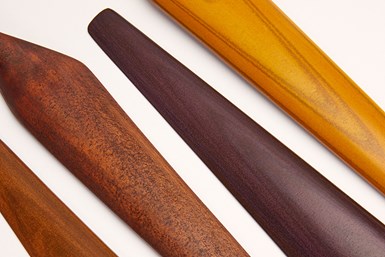Desktop Metal Develops Additive Manufacturing Process for Wood Parts
The Forust additive manufacturing process upcycles wood waste into high-quality wood end-use parts that can be used in a variety of industries.

The Forust AM process can manufacture beautiful, functional and innovative wood products such as propellers.
Desktop Metal has launched the Forust additive manufacturing (AM) process to sustainably produce functional end-use wood parts using its single-pass binder jetting AM technology. The Forust process upcycles waste byproducts from wood manufacturing (cellulose dust) and the paper industry (lignin), and rematerializes functional wood parts through high-speed 3D printing, creating digital grain throughout the part.
This high-speed 3D printing technology offers architects, designers and manufacturers a new path to produce luxurious custom wood pieces for home decor, interiors, transportation and architectural design with a superior environmental footprint, new geometries and quality unavailable from subtractive wood manufacturing technology.
Through advanced CAD software, proprietary materials and Desktop Metal’s binder jetting mass production platforms, the Forust process can manufacture beautiful, functional and innovative wood products. At the core of this innovation is the Forust process, which combines two waste streams from traditional wood production, sawdust and lignin, to sustainably produce isotropic, high-strength wood parts.
Depending on the size of the parts, Forust can manufacture wood products using either the Shop System or a custom version of the new RAM 336 3D printer, which supports prints up to 2 m3 in volume at speeds in excess of 100 L/hr. of parts. During the printing process, layers of specially treated sawdust are spread and selectively joined by a nontoxic and biodegradable binder. Digital grain is printed on every layer and parts can then be sanded, stained, polished, dyed, coated and refinished in the same manner as traditionally manufactured wood components.
The company says the Forust process offers nearly unlimited design flexibility. From exotic grain structures to grainless wood, Forust can digitally reproduce wood textures and a myriad of grain types. And, because they are made from a wood and bioresin compound, these parts exhibit the functionality and stiffness in line with conventional wood.
Related Content
-
World’s Largest Metal 3D Printer Seen at Ingersoll Grand Opening Event
Maker of large additive and subtractive machines adds capacity in Rockford, Illinois.
-
10 Important Developments in Additive Manufacturing Seen at Formnext 2022 (Includes Video)
The leading trade show dedicated to the advance of industrial 3D printing returned to the scale and energy not seen since before the pandemic. More ceramics, fewer supports structures and finding opportunities in wavelengths — these are just some of the AM advances notable at the show this year.
-
Aluminum Gets Its Own Additive Manufacturing Process
Alloy Enterprises’ selective diffusion bonding process is specifically designed for high throughput production of aluminum parts, enabling additive manufacturing to compete with casting.














